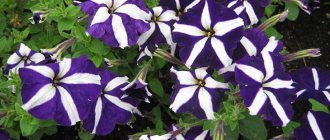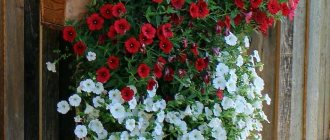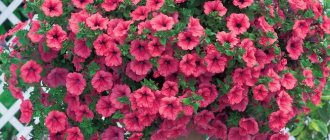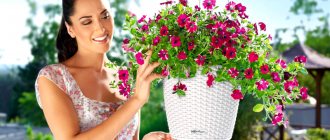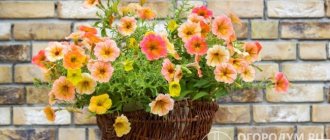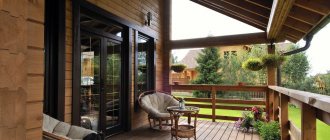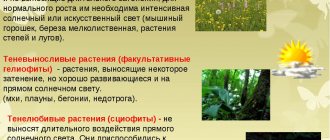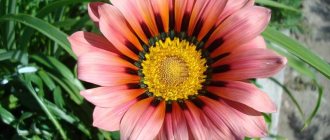Bright petunias are the most popular annuals. They are unpretentious, beautiful, and today breeders offer an amazing selection of shapes and shades of flowers - for every taste. These plants can be grown not only in the garden, but even on the balcony of a city apartment. True, not all of their varieties are suitable for this, and many questions arise on the topic: ampelous and cascading petunia - differences and common features. Not to mention that there are also differences between the canopy and bush groups.
Features of the flower
Why the crop is attractive to gardeners:
- a rich palette for creating landscape design, decorating flower beds and flowerpots;
- unpretentiousness in cultivation;
- compatibility with any crops on the site.
These representatives of the flora are suitable for growing in gardens and balconies
There are three types of petunia:
You can identify a bush variety by its appearance; the shoots are directed upwards or to the sides. However, the differences between ampelous and cascading petunias are less obvious to a novice gardener.
What's more beautiful
Knowing about all the features of ampelous and cascading petunias, you can independently determine what exactly you need. The choice depends on the main purpose, and as for beauty, both types of flowers are very decorative.
Petunia is considered a fairly easy flower to grow. It is universal in use; the variety of species and hybrids allows it to be used anywhere. Now you know how to distinguish ampelous petunia from cascading petunia, all that remains is to make your choice.
Ampelous and cascading petunia: the difference
In appearance, the ampel variety has a number of features:
- The shape of the inflorescences resembles bells. Dozens of flowers are located along each shoot, in the axils of the plant;
- the palette includes colors from white to purple. Typically, the inside is darker than the petals;
- stems of varying lengths, about 30-100 cm. During the growth period, the shoots fall to the ground, rather than falling apart to the sides. Thanks to this, it is possible to grow in hanging flowerpots and shape the crown at the discretion of the gardener;
- Some varieties have large buds up to 10 cm in diameter. In such cases, you don’t have to wait for a large number of flowers. Other varieties are distinguished by buds from 3 to 7 cm, arranged in 3 or 10 pieces. on a sprout.
For your information! To decorate a wall with cascading vines, you should not pinch petunia shoots.
One flowerpot can contain flowers of different shapes and shades
How does cascade petunia differ from hanging petunia:
- the plant has strong elastic shoots that do not break under gusts of wind. The length of each of them reaches 1.5 m. A solid mass of greenery grows from the axils. The stems begin to grow upward, but when they reach a certain height, they bend toward the ground;
- in appearance the crown looks like a ball framed by a cascade of flowers;
- the buds reach a diameter of 5 cm. Moreover, on one plant all the flowers are the same size.
Important! During flowering and bud formation, you should water and fertilize the flower more often and do not forget about careful care.
Ampelous and cascading petunia - difference:
- ampelous has thin stems up to 1.5 m in length. The cascade plant is distinguished by thick lashes of about 2 m;
- the direction of growth of ampelous petunia is downward;
- buds of ampelous varieties have different shades and numbers, while the parameters of cascade varieties are stricter: all flowers are the same color and size;
- The best option for hanging containers is hanging containers. Ball-shaped varieties prefer floor vases, pots, flower beds and other conventional planting methods.
Description of varieties
Thanks to the variety of varieties of ampelous petunia, you can choose a plant of a specific color, size and type of cultivation.
Popular types
– grows strongly to the sides.
| Variety | Description |
| "The Snow Queen" | – snow-white color; – fresh aroma; – up to 80 cm in length. |
| Diamond Pearly Sheds | – pale pink color; - nice smell; – size up to 100 cm |
| "Explorer" | – considered the most popular type; – variety of colors; – record sizes – up to 1.5 m; – has a strong shoot structure; – wind resistant; – protection from rain due to the presence of a viscous substance on the buds. |
| "Salmon Shedes Velvet" | – rare apricot color; – the variety was bred by Czech flower growers. |
| "Easy Wave Red" | – the length of the stems reaches 100cm; – buds are bright red |
| "Catherine" | – hybrid; – coral and pale pink shades with veins; – up to 6 cm in diameter. |
| "Svetlana" | – branched stems up to 1 m in length; – wave-like shape in the form of a funnel; – presence of bright pink veins. |
| "Mashenka" | – stem length up to 80 cm; – bright pink color with a yellow center. |
| "Ramblin Neon Rose" | – large flowers; – lifting up by 35 cm; |
| "Black Velvet" | – unusual black color of flowers; – bud diameter 8 cm; – the height of the bush reaches 35 cm. |
Thanks to the extensive number of varieties, you can create entire compositions by combining the colors and shapes of plants. Ampelous and cascading petunia is suitable for growing both at home and in open ground.
Varietal varieties
It is necessary to distinguish between two types of plants: true ampelous petunia and cascading petunia. The difference between the shoots lies in appearance, stem length, growth, adaptation and cultivation characteristics.
Flower growers distinguish the following varietal characteristics of plants
| Variety name | Personality Traits |
| "Avalanche" | – blooms for a long time; – often used to decorate balconies, loggias or gazebos; - variety of flowers according to their color. |
| "Shock Wave" | – a form resembling a hybrid; – flower diameter 3-4 cm; – plant length reaches 70 cm; – propagated by cuttings; – blooms 10-14 days earlier than other varieties. |
| "Velveteen" | – velvety foliage and petals are noted; – is an excellent honey plant; – late flowering period; – requires the use of a growth regulator and systematic pinching. |
| "Opera Supreme" | – belongs to the F1 series of hybrids; – suitable for growing indoors at any time of the year; – the flower is unpretentious in care. |
No less popular varieties include supercascade petunia. It is distinguished by large flowers reaching 12 cm in diameter. It blooms quite early and for a long period of time. Often used for growing in balcony pots, hanging baskets and flowerpots.
When a buyer is faced with the choice of one plant or another, many people wonder: what is the difference between ampelous and cascading petunia.
Hybrids of cascading petunias have three varieties:
- flexible and strong stems growing downward;
- stems grow only upward with gradual falling down;
- semi-ampeles with short lashes (super cascade petunia).
Understanding all the main differences, characteristics of growth and cultivation, you can choose the most suitable plant for your home or garden.
How to distinguish ampelous petunia from bush petunia
Bush petunias are the least demanding to care for; just pinch the top. This variety is the most common and includes several varieties of different shades. The shape resembles a small tree with a cloud of red, purple or variegated crown. These representatives reach 30 cm in length, with the stems growing upward. There are terry, small-flowered and large-flowered varieties.
Features of the bush variety:
- rounded green shoots;
- the roots lie shallow in the ground;
- the entire green mass of the plant is covered with a small fluff;
- each variety is distinguished by large flowers, the diameter of which is at least 10 cm;
- the peduncle is short, the stems are erect;
- The transition of shades on the flowers is smooth, gradient. There are contrasting inclusions on the edges;
- the edges of the buds can be with sharp teeth, wavy or corrugated;
- after the end of the flower formation period, the seed box remains.
Note! Bush petunia does not require shaping; it is enough to plant it correctly, pinch it and trim it.
How to distinguish seedlings of ampelous petunia from bush ones
It will not be possible to identify the difference and signs from small seedlings, since all varieties during this period look the same.
Only after the first shoots of the seedlings appear, it will become clear how the formation is proceeding.
Ampelous petunias begin to grow side stems. The shape of such a flower will resemble a small bush without a main stem.
It is common for a bush variety to begin growth from the main vine, from which lateral shoots will later emerge. As a rule, this happens after pinching or the appearance of the first buds.
Important! Ampelous and cascading petunias are planted 2 weeks earlier, since germination is slow. Before planting in the ground, it is important that the soil sits for a day.
Features of growing petunia:
- cultivation occurs in seedlings at the end of March or beginning of April;
- Before planting in open ground, you should make sure that the air is warmed up;
- use pots with a wide top, since the plant’s root system is located close to the surface;
- It is important to ensure that the soil is not flooded with water, otherwise there is a risk of fungal disease.
Plant care rules:
- the flower garden must be kept clean, it is important to remove weeds;
- the soil is dug shallowly;
- fertilizing in the form of liquid solutions is administered 2 times a month;
- When flowers appear, fertilize with phosphorus and potassium.
Petunia is the real queen of the flowerbed. It is a good option for decorating a garden, balcony, terrace, window sill or building wall. These flowers are planted in flowerpots, pots and open ground. Sunny areas protected from strong winds are suitable for planting.
The shape of this plant is determined genetically, and the method of cultivation depends on it. What is the difference between ampelous petunia and cascade and bush petunia:
- short stems;
- flowers on one plant can be of different shapes and shades;
- greenery immediately falls from the pot to the ground.
To distinguish ampelous petunia from ordinary petunia, you should pay attention to the method of shoot formation. The first does not have a main stem. This is exactly what you should focus on when choosing, so as not to buy a “pig in a poke.”
Features of growing ampelous varieties
Hanging varieties are most often grown in hanging pots and boxes. When choosing a container for planting, taking into account the needs of a powerful root system and the ability for abundant flowering, preference should be given to pots and flowerpots of large volumes (from 5 liters for one plant). You can also allocate a separate area in the garden for petunia - a clearing intertwined with green shoots with multi-colored buds and flowers looks very beautiful. Cascading varieties are sometimes planted in open ground near poles and fences, resulting in bright supports entwined on all sides.
The best place for planting hanging varieties is in hanging pots and flowerpots, so the flowers not only look beautiful, but also do not interfere with other plants
Sunny or semi-shaded places, protected from strong winds that can damage thin long vines, which will lead to a decrease in decorativeness, are considered optimal for placing hanging plants In addition, varieties are divided into low-resistant varieties, whose flowers (and even shoots) do not respond well to getting wet, and hardy varieties, which are slightly susceptible to the negative influence of precipitation. Cascade varieties with thicker and more powerful stems are more resistant to external factors and various types of damage.
Experienced gardeners do not recommend planting ampelous petunia in flower beds next to other plants, as it grows rapidly, covering a large area and practically “drowning out” everything around it.
Care instructions
There are no significant differences in caring for the species of petunias under consideration. Plants require frequent watering, however, to avoid rotting of the roots and shoots at the base, you need to ensure that water does not stagnate in the soil.
An experienced gardener talks in detail about caring for cascading petunia "Typhoon Silver" in the following video:
In addition, the main agrotechnical measures include:
- feeding To obtain lush and long-lasting flowering, petunias must be fed periodically. To do this, it is best to choose complex water-soluble mineral fertilizers with a high content of potassium and phosphorus. During flowering, feeding is done at least once every 7-10 days;
- pruning and removing seed pods . To ensure that plants do not reduce the intensity of flowering and do not lose their decorative appeal throughout the season, it is necessary to promptly remove faded flowers along with the seed pods. If this is not done, petunia enters the fruiting phase, devoting all its energy to seed ripening, while new flowers are not laid;
- pinching _ Hanging and cascading varieties (unlike bush varieties) do not need to be pinched. However, if, in the event of a violation of the light or temperature conditions, the plant stretches strongly upward or the bottom of the stems is exposed, experts recommend tweezing or pinching the main growth points. This will stimulate the formation of new shoots and give the plant lushness.
Dying flowers should be removed throughout the season to prevent seed maturation
Which type of petunias looks more attractive - every lover of these luxurious flowers will decide for himself. The varietal diversity of the crop allows you to create incredibly beautiful compositions not only in the field of landscape design, but also to originally decorate balconies, loggias, terraces and home interiors with these beautiful plants in hanging pots. Experienced gardeners often combine hanging and cascading petunias with bush petunias, expanding the possibilities for demonstrating their design abilities.
How not to confuse ampelous and cascading petunias? All the differences between the species, features of choice and care
Petunias are very unusual and beautiful flowers. They can be found in almost every garden, because no one can resist beautiful flowers that resemble butterflies. These flowers have a huge variety of shades from snow-white to dark purple.
Bush petunia can be easily recognized, but cascading and hanging petunia are regularly confused. To understand in as much detail as possible how they are similar and how they differ, let’s look at each of them separately.
Ampelnaya
Ampelous petunia has a number of properties characteristic only of it. It is almost impossible to confuse it with most other types of petunias. The length of its shoots can reach more than a meter, but the shoots neatly fall down and do not stick out in all directions. Because of these properties, it is most often grown in hanging pots - in them it looks most elegant and luxurious. Read about what other varieties of petunias can be grown in flower pots here.
Petunia has very delicate and soft leaves. Older leaves, which are closer to the root, are usually larger in size than young leaves on the shoots.
What common
Cascade and ampelous petunia belong to the genus of herbaceous perennial semi-shrub plants of the Solanaceae family. The region of origin is South America. In some regions of Brazil, Uruguay, Argentina it grows in natural conditions.
Both varieties require compliance with the same principles of cultivation and care. They can be planted in a variety of hanging structures or in the garden bed. It is allowed to plant cascading and ampelous petunias in one container. This will allow you to get an original, attractive flower arrangement, dotted with numerous inflorescences of various sizes and shades.
How are these types different?
These two plants are surprisingly similar, because not only do they belong to the same species, but they are also close relatives. Still, there are differences between them. Their shoots are of unequal length and thickness. In ampelous petunia they are drier and brittle.
Cascade petunia has an amazing climbing ability and can be used to decorate hedges. Differences are also visible in the size of the buds. To make the comparison more clear, the table is filled with basic data about these plants.
comparison table
| Description | Cascade | Ampelnaya |
| Shoot size | Up to 1.5 m, grows quickly, can wrap around a support. | Up to 1.2 m. |
| Size and color of flowers | Large flowers of the same size, similar shades. | Flowers up to 8-10 cm in size, of different shades, often two-color. |
| Subtleties of cultivation | Cuttings and seeds | |
| Required soil | Fertile, ideally black soil | |
| Feeding, watering | Demanding on fertilizing and watering | |
| Landing places | Flower beds, pots, free areas of the garden, flowerpots, tubs | Wickers, tubs, flowerpots. |
| Bloom | From mid-June continuously until the start of frost. | |
| Do I need to pinch? | Yes, so that the flower grows faster and more accurately. | No |
| Features of growth | First they stretch upward, then spread out to the sides | Immediately pulled down |
Difference in care
Since ampelous and cascading petunias are not very different from each other in origin, there will not be too many individual characteristics when caring for each of them, but you still need to take into account some nuances in order to get the most beautiful and healthy plants.
For example, it is better to plant ampelous petunia in open ground after consistently warm days have established itself - any frost can be critical for it. It is believed that the best time to transplant ampelous petunia to its permanent place is the beginning or even mid-June.
You can also use garden boxes or flowerpots for growing - petunia will look beautiful anywhere. But you don’t need to plant it next to other flowers. Petunias grow very quickly and will simply choke out all the other plants in the flowerbed. A much better option would be to allocate a separate corner for these flowers - then soon it will be covered with a luxurious fragrant carpet of buds.
Ampelous petunia is very demanding on fertilizers and watering . You need to be especially careful at the beginning of flowering, when the buds are just blooming - at such moments the flower is extremely sensitive to the amount of moisture and the quality of fertilizing. You should not allow water to stagnate near the roots of ampelous petunia - they very quickly begin to rot and young shoots die.
Cascade petunia has its own characteristics, although in essence it is one of the subspecies of the canopy petunia. So, for example, for the most comfortable growth, it will need a separate small clearing - cascading petunia spreads its lashes, forming a natural flowerbed with a diameter of up to one and a half to two meters.
Petunia also grows well by clinging to support - for example, a pole or a fence. However, in this case, it will have to be specially directed in the right direction so that the flowers do not begin to creep on each other and hang down.
When planting cascading petunias, you should always ensure that the distance between seedlings is at least 50 cm . Otherwise, the shoots will simply choke each other; they will not have enough space to grow and show all their beauty.
If you plan to grow cascade petunia in pots or tubs, then you need to make sure that their volume is large enough - at least 5 liters of soil per shoot. If you want to plant 2 or 3 plants in one container at once, then it is better to take a pot larger than 15 liters.
Also, in order to get a cascading petunia of a beautiful shape and achieve the most abundant flowering, it must be regularly plucked , which in no case should be done when working with hanging varieties of petunia.
Technology and methods of sowing seeds for seedlings
There are several ways to sow tiny seeds:
- in a mini-greenhouse;
- into hydrogel;
- in the snow;
- into peat tablets.
The first method uses a mini-greenhouse to grow seedlings. It can be purchased at a garden center or made from a small container with a transparent lid. It is easier to maintain an optimal microclimate inside the structure.
Attention! Be sure to make drainage holes to drain excess liquid.
As a substrate, gardeners recommend using a mixture of equal proportions of peat, sand, steamed garden soil and humus. The resulting soil will be light, nutritious, structured and have an optimal pH level. The container is filled with soil mixture, watered and set aside for 24 hours. Then, the seeds are laid out on the surface of the substrate.
The most convenient way to do this is with a toothpick or mix the seed with sand and “salt” the soil. When using coated material, you need to carefully break the integrity of the nutritional membrane with a toothpick. The seeds will need light to germinate, so digging is not required. Just lightly press the soil and spray it with a spray bottle. Cover the greenhouse with a lid and place it in a warm place with a temperature of at least 22⁰C.
To clearly see the unsown areas of the container, gardeners sow seeds in the snow. To do this, the container is filled two-thirds with soil, and the remaining space is filled with compacted snow. Melt water will carry away the grains. Distribute them evenly over the surface. It was noted that snow water has a positive effect on the further development of seedlings.
Know! Some gardeners sow seeds in hydrogel. For best results, it is recommended to saturate the substance with a weak solution of fertilizers or mix it with soil. The technology is similar to sowing in a container.
The convenience of peat tablets for growing seedlings has been appreciated by many summer residents. The peat in the washers has already undergone special treatment, so the seedlings will not be afraid of fungal diseases. Small cylinders allow you to carefully transplant seedlings without damaging the root system. The sowing technology will remain the same - 1-2 seeds are placed in the center of the prepared tablet using a toothpick. Cultivation is carried out in a mini-greenhouse. The tablets should be pre-watered with warm water until they stop increasing in height.
The main problem when using peat tablets is the rapid drying out of the substrate and the appearance of mold from waterlogging. It is removed with a cotton swab, and then the surface is treated with phytosporin.
Seedling care
7-10 days after sowing, the surface of the soil will be covered with tiny thin sprouts. At first, they are ventilated daily and, if necessary, the soil is sprayed with a sprayer. Be sure to remove excess condensation. High humidity often provokes the development of blackleg. It is almost impossible to save seedlings from this scourge.
Further care for petunia:
- Keep at a temperature of 20-23⁰C.
- If necessary, additional lighting is used up to 12-14 hours a day.
- The shelter from the greenhouse is gradually removed, after which once every 2 weeks the temperature background is reduced by several degrees for hardening.
- The irrigation regime depends on the air humidity in the apartment. If the house is hot, spray the seedlings twice a day; if humidity is high, reduce watering to 2-3 times a week.
- Picking is carried out at the stage of development of the fourth leaf. Use the transfer method, trying to maintain the integrity of the earthen ball around the roots.
- Choose spacious pots for picking or repeat the event in a month.
- After 10-14 days from picking, start feeding the seedlings. Alternate root and foliar feeding with a complete mineral complex. The frequency of application is 2 times a month.
- Planting in a permanent place or in an outdoor container is carried out after the return frosts have subsided in your region.
- Petunia is planted in a well-lit place with fertilized loamy soil. Follow the recommended planting pattern.
Remember! Nitrogen fertilizers provoke active growth, so they are used twice during cultivation - after picking and after transplanting. In the future, give preference to the potassium-phosphorus complex.
How to choose?
The huge variety of varieties and types of petunias can make an inexperienced gardener seriously confused. Indeed, it is not immediately clear whether ampelous or cascading petunias are suitable for decorating a terrace, summer cottage or balcony. But it's actually quite simple. You just have to pay attention to the size of the area that you want to enliven with these lovely flowers.
Ampelous petunia will look great in large garden areas , but may look a little tacky on a tiny terrace.
Petunias are rightfully one of the best flowers for decorating your home and garden. They will organically fit into almost any space, and even the most picky gardener will definitely find the variety that suits his heart. But in any case, no matter what petunias you choose, these flowers will delight your eye with their unpretentiousness and exquisite beauty for a very long time.
If you find an error, please select a piece of text and press Ctrl+Enter.
What is the difference between ampelous petunia and cascading petunia?
Petunias are amazingly beautiful flowers; you can see them in almost every garden. Who would refuse a green cloud strewn with multi-colored “butterflies”. The variety of species and rich color palette allows you to create a unique landscape design. There are bush, ampel and cascade varieties of petunias.
When identifying bush varieties, there are practically no mistakes; hanging and cascading varieties cannot always be distinguished. This is especially difficult for beginners to understand. We will try to give comprehensive answers to the question of what constitutes ampelous and cascading petunia, and what are the differences. But first, let’s describe each of the species of plant groups “arguing” with each other.
Photo
Check out the photos of both types of flowers to understand the differences between them.
Ampelnaya:
Cascade:
Features of ampelous petunia
It is impossible to answer the question of how ampelous petunia differs from cascading petunia without a detailed description of the types of petunias. This is not only the appearance, but also the features of growing and caring for petunias.
Description
The ampelous petunia has its own distinctive features in appearance:
- The length of succulent green shoots can vary, from 30 to 120 cm. During growth, the shoots fall down and do not fall apart. Thanks to this, the plant can be given the desired shape. Therefore, it is grown in hanging containers.
- The size of soft leaves with slight pubescence depends on the age of the petunia: old ones are larger, and young ones are smaller.
- There are many flowers on the plant, they are located along the length of the entire shoot, in the axils. The shape of the flower resembles a bell.
- There are varieties with large flowers with a diameter of up to 10 cm; there are not many of them on the plant. Multi-flowered species have more buds, but they are small in size (from 3 to 8 cm). On one shoot at the same time there can be flowers from 3 to 10 cm. On the same plant, buds can be of different sizes and shades.
- The color palette is rich, from pure white inflorescences to dark purple. Most often, the petals are two-colored, the inside of the bell is a more saturated color.
Landing Features
Planting and caring for ampelous and cascading petunias has its own distinctive features. This can be open ground, flowerpots, using seeds, propagation by cuttings and pinching procedure.
Attention! The principle for growing super cascade red F1 or ampelous petunia is the same, as is the plant care technology. It is possible to grow both species in one pot to obtain a varied, beautiful and original composition with numerous buds of different shades and sizes.
After familiarizing yourself with the various methods of growing petunias, you can choose the most suitable option. It is equally important to know about common ampelia diseases and plant care methods. For example, super cascading blue petunia f1 looks great in flower beds, while hanging varieties are ideal for decorating balconies and gazebos.
Petunia cascade
Cascade petunia is a subspecies of ampelous petunia. Although it has its own characteristics.
Description
- Cascading petunias are distinguished by elastic, “well-fed” shoots, which can be up to 1.5 meters long. They don't break even in the wind. The green mass grows due to axillary shoots. Initially, they rise up, and after reaching a certain length, they hang.
- The plant resembles a ball with long hanging vines when planted in a hanging pot.
- The buds are large, up to 5 cm, all flowers on the plant are the same size.
How to properly grow cascade varieties of petunias, watch the video:
Landing Features
Since cascading petunia shoots tend to grow quickly, it can be planted in different ways:
- When grown on the ground, it needs to be given a separate flowerbed; the plants scatter vines, forming a flowering clearing with a diameter of up to two meters.
- Supports in the form of pillars and fences are also suitable, you just need to direct the lashes in the right direction. Then the support will be entwined on all sides. When planting, you need to maintain a distance of at least 40 cm, otherwise the plants will choke each other.
- If tubs or wickers are used to grow plants, they must be large in volume, at least 5 liters. If you plan to plant 2-3 plants, you will need a capacity of up to 15 liters. Look at the photo how amazing the flowers look in a wicker basket.
- You can grow petunia on a balcony, loggia, or terrace.
The main thing is to follow the technology of growing and caring for the plant.
What is the difference between ampelous petunia and cascading petunia?
Bright petunias are the most popular annuals. They are unpretentious, beautiful, and today breeders offer an amazing selection of shapes and shades of flowers - for every taste. These plants can be grown not only in the garden, but even on the balcony of a city apartment. True, not all of their varieties are suitable for this, and many questions arise on the topic: ampelous and cascading petunia - differences and common features. Not to mention that there are also differences between the canopy and bush groups.
Ampelous and cascading petunia: the difference
At first glance, the cascade and ampelous varieties of this plant are very similar with their long branching shoots. But in fact, despite the flowing branches and bright simple flowers, there is a difference between them. This division was adopted due to the fact that their bushes are formed differently, and there are also differences in the size of the flowers.
What is ampelous petunia
This group includes plants that, thanks to their long, hanging shoots, can be used for growing in hanging containers and pots. Representatives of this variety are distinguished by long and abundant flowering. In this case, the flowers can have the shape of a bell or a funnel, and their shade can be white, purple, crimson, etc. There are hybrids with a flower diameter of 15-90 mm, with colored veins, and a spectacular dark core.
Important! Ampelous varieties also feel good on a flat surface, then they form a spectacular variegated carpet.
What is petunia cascade
A very beautiful variety. Its flowers can be red, pink, or purple; there are even fantastic combinations of two shades. How cascading petunia differs from ampelous petunia is its size. Representatives of this group require much more living space.
For normal development of one specimen, a container with a volume of at least 5 liters is required. If you want to grow two flowers in one container, then you should count on 15 liters at once. It is not surprising that such containers are not used as hanging ones. Although in a large container, a plant of this type can easily stand on the balcony all summer. It is not at all necessary to plant it in a flowerbed as a bush variety.
Cascade of flowers
How to distinguish ampelous petunia from bush petunia
In addition to the listed varieties, there is another large group - the bush variety. It is considered the most numerous and diverse in terms of appearance, since it includes both low-growing varieties, in which the flower diameter does not exceed 5 cm, and taller and larger plants, with flowers up to 16 cm in diameter.
The main criterion for classifying a variety or hybrid into this group is that the shape of the bush can be maintained without special pruning. At the same time, the bush can be very lush, but it does not need special care. It is enough to simply pinch the tops of the stems so that the plant sends out side shoots.
Both the hanging and bush varieties are very similar, especially at the seedling stage. In order to say with confidence which annual plant we are talking about in a particular case, you need to wait until the formation of side shoots begins. Even in small plants, quite noticeable differences appear at this stage.
Ampelous varieties begin to send out side shoots almost immediately, so the plant takes on the shape of a bush, but it does not have any one distinct central stem. In bush petunia, if you do not pinch the branches, side shoots will not appear, but the main stem will stand out clearly, and over time, buds will begin to bloom on it.
Important! It is almost impossible to distinguish seedlings of ampelous petunia from bush or cascade ones. Small plants of these species look the same and have no significant differences. All that remains is to wait for the moment when shoots begin to form.
Is it necessary to pinch Petunia grandiflora?
It is not necessary to pinch large-flowered petunia; it bushes well on its own. A petunia seedling first grows upward with one stem, then its side shoots begin to grow. ... This can still be corrected after transplanting the petunia seedlings to a permanent place. Pinching, regular watering and fertilizing will help.
Interesting materials:
What threads can be used for a Shambhala bracelet? What new independent states emerged after the collapse of the USSR? What regions and countries were part of the Roman Empire under Trajan? What wallpaper to choose for a white brick wall? What dangerous consequences can a hurricane cause? What operators are used to retrieve data from tables? Which nuts are better and healthier? What nuts are the healthiest for humans? What nuts are the healthiest for a child? What mistakes reduce your grade by one point when putting on a gas mask?
How to distinguish ampelous petunia from simple one
It should be noted that the term “simple petunia” is used in relation to a plant with a certain flower structure. This is a whole group of varieties and hybrids. It includes three varieties - bush, ampelous and cascading flowers. Thus, it would be advisable to consider another question - how does ampelous petunia differ from its cascading relative.
Three criteria should be highlighted here:
- shoots. Despite all the external similarities, both groups are different. Ampelous hybrids have more flexible and longer shoots that seem to flow down from a hanging container. Their length can exceed 1 m. Cascading varieties also have quite long shoots, but their difference is that they grow upward. It’s just that these shoots are quite powerful, and over time they begin to fall down under their own weight, forming a cascade. Their length can reach 1.5 m. At the same time, cascading specimens form more shoots, so the bush looks more lush,
- flower sizes. The differences between ampelous and cascade petunia are that in the former, flowers of different sizes can bloom simultaneously on one plant, while in cascading varieties, all flowers have approximately the same diameter - 4-5 cm. In addition, in this group, two-color varieties are more common,
- features of bush formation. Ampelous plants, as already noted, quickly form side shoots; they need to be pruned to maintain a given shape. These varieties are grown in hanging baskets. Cascade petunia also grows well, but more powerful shoots require support. Just two specimens of such annuals form a substantial-sized flowerbed.
Petunia in landscape design
But when it comes to the basic rules of care, there are no particular differences. Both ordinary petunia, ampelous petunia, and cascade petunia are not demanding in terms of soil acidity or its composition. In any case, planting in open ground is carried out after the end of frost, when stable warmth has established. Many popular plant hybrids, at least in early summer, love good light, but there are also those that prefer diffused light or partial shade. In order for this annual to please the owner with abundant flowering, fertilizing with organic fertilizer is required.
Growing ampelous or cascading petunia on your summer cottage or balcony is not at all difficult if you know and follow the rules for caring for these plants.
Growing procedure
From seeds
- prepare a container with soil and sand substrate;
- it is necessary to use high-quality soil;
- before planting, flower seeds are mixed with sand in a ratio of 1:5;
- It is better to use not pure seeds, but in a shell, to protect the plant from diseases and mechanical damage;
- February and March are ideal months for planting;
- if there is insufficient lighting, you need to organize it yourself;
- it is necessary to moisten the already sown seeds from a spray bottle and cover with a transparent film;
- the room temperature should not be higher than 25 degrees;
- when the first shoots appear, the flooring should be removed;
- watering should be minimal;
- Nitrogen fertilizer can be used as a top dressing several times a month.
Topping
In order for petunia supercascade burgundy to grow with lush flowers, it is necessary to systematically pinch the plant. The procedure involves removing the shoots when they reach the top of the stem by 10 cm.
The next pinching is carried out when the shoots reach 15 cm in height. The trimmed plants can be placed in water. They will take root and can be used to grow flowers in pots or boxes.
Picking
The procedure is carried out to give the plant abundant growth, flowering and nutrition. Three weeks after the shoots emerge, the petunia should be placed in a separate container.
The soil is first thoroughly moistened so that the plant can be removed safely. Transplanted flowers are stored in a well-lit, ventilated room with an air temperature of at least 22 degrees.
Planting in open ground
In May, the plant can be transplanted into the soil, having first moistened it and mulched it with peat or humus. It is equally important to harden the seedlings before they are transplanted into open ground. It is enough to take it outside for five days.
Propagation by cuttings
Cuttings should be cut at an angle. It is important to ensure that the shoots already have several leaves. The cuttings are placed in warm water. As soon as they begin to take root, the soybeans and petunia can be placed in the ground.
With this method of transplantation, it is possible to grow supercascade blue petunia f1 no earlier than 35 days later.
Planting in flowerpots
Cascade and ampelous petunia look beautiful in hanging flowerpots. This is an excellent decoration for any balcony, loggia or gazebo. The soil is selected in a specialized store, as it must be loose, light and waterproof. You should not plant flowers with different flowering periods and sizes in the same pot. Growing conditions must be the same.
Ampelous or cascading - how to distinguish petunias?
Petunia is often used to create flower arrangements in the house or at the dacha. She maintains a colorful atmosphere and a cheerful mood. Beautiful large inflorescences and bright color made it popular among gardeners. On balconies and terraces, in areas you can see varieties such as hanging and cascading. The plant can bloom for several months, but requires some care.
Petunia (lat. Petunia) is a semi-shrub plant belonging to the Solanaceae family. It is grown as a decorative balcony flower, as an annual crop in gardens. The most popular are ampelous, cascading, and bush petunias. The last type is slightly different from the first two - the shoots are erect and grow like a bush. Today we will talk about ampelous and cascading petunias.
Which type to choose for a garden plot
For cultivation, ampel or cascade varieties are chosen, taking into account their differences from each other. In addition, the determining factor is the main purpose of the culture:
- To cover areas of soil with a flower carpet that will bloom throughout the summer, it is recommended to choose cascading petunias. The shoots, if you do not pinch them, will grow independently over the entire surface, without requiring additional care;
- To decorate walls and create the feeling of a hanging structure, hanging varieties are chosen. They are used to decorate arches, as well as the upper tiers of tall flower arrangements;
- Both ampelous and cascading varieties are suitable for growing in floor vases. Their difference at the initial stage of growth when using this option will be almost imperceptible. If you regularly shape the bush by pinching, the differences can be minimized;
- To decorate walls and create a “hedge” effect, choose cascading petunia. Its difference with this growing option is the ability to wrap around a support and completely cover it.
Description of ampelous petunia
First you need to figure out what the word “ampel” means? The name comes from the German word ampel - hanging vase. Hence, flowers that are grown in hanging flowerpots, flowerpots, and baskets are called hanging flowers.
Ampelous has elastic flowing shoots. Their length can reach from 30 to 120 cm. The leaves are soft, green with slight pubescence. On the shoots there are many flowers shaped like a bell. Their diameter ranges from 3 to 10 cm depending on the variety.
Appearance also depends on the variety. The stems point down, hang down, have loops, and are most often used for hanging pots and balcony boxes. Flowers can be one-color or two-color. The middle is a more saturated shade.
Varieties
Ampelous petunia comes in unusual shades and different shapes. The hybrid varieties introduced over the last 10 years are more stable and feature abundant and long-lasting flowering.
The best varieties of ampelous petunia are:
- Surfinia - the variety comes in a variety of shades (grown using cuttings). It is characterized by good branching and resistance to weather conditions.
- Snow Queen - shoots of medium length, white flowers with a delicate aroma.
- Velvet - leaves and flowers have a velvety surface. It is considered a good honey plant.
- Avalanche - a series of varieties represented by “Avalanche Pink”, “Avalanche White” and “Avalanche Purple”, characterized by high decorativeness and a long flowering period, increased fragility.
- Opera - flowers are predominantly red, pink and white, the buds are small.
- Ekaterina - belongs to the hybrid varieties. The flowers are about 5 cm in diameter and have a yellowish-reddish tint.
